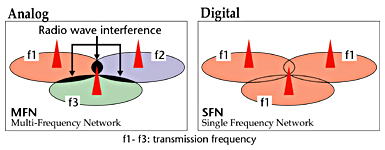|
Digitalization of Japan's Terrestrial
Broadcasting
Japan's frequency congestion:
50 times greater than the United States
 |
 Figure
1. Concept of MFN and SFN Figure
1. Concept of MFN and SFN
|
Terrestrial television broadcasting in Japan has been considered as
a basic medium closely related to people's lives. Presently in Japan,
analog terrestrial broadcasting is available in almost the entire country.
Analog terrestrial broadcasting utilizes MFN (Multi-Frequency Network),
a transmission scheme that uses a different transmitting frequency in
each service area (Figure 1). MFN requires the use of many transmitting
stations to reach a national audience due to radio wave interference
in each area covered by multiple radio signals. Approximately 15,000
transmitting stations were established throughout Japan and almost all
of the available frequencies for television broadcasting have to be
allotted to analog broadcasting services. The degree of frequency congestion
in Japan is approximately 50 times that of the United States and twice
that of Britain (estimated by the number of broadcasting stations compared
to landmass). In terms of sound broadcasting, the frequency bands allocated
to analog AM/FM broadcasting are in full use, making it difficult to
spare channels for digital sound broadcasting.
|
OFDM
OFDM is one of the digital data radio transmission systems that
operate by compiling several groups of digital data (comprised
of 1s and 0s), and then sending each group out as one signal.
OFDM inserts a lengthy signal partition called a "guard interval"*
between each signal. A superior characteristic of this arrangement
is the elimination of multipath signal interference (Figure 2).
This characteristic gives the system strong mobile reception capability,
allowing possible future application to TV and sound service for
train/subway/bus/taxi passengers or for an ITS (Intelligent Transportation
System). An SFN (Single Frequency Network) is also technically
feasible.
*Guard interval:
When a receiver detects synchronized signals from multiple transmission
facilities, the varying distances between the receiver and each
broadcasting facility produce time differences among the identical
signals reaching the receiver, creating obstructive radio waves
that prevent clear reception. In contrast, by using OFDM, the
same types of signals can be properly received during a detection
period as long as any delay is within the specified guard interval.
|
 Figure
2. Relationship between OFDM desired waves and obstructive waves Figure
2. Relationship between OFDM desired waves and obstructive waves |
The ISDB-T television broadcasting scheme is using segmented BST (Band
Segmented Transmission)-OFDM (Orthogonal Frequency Division Multiplexing).
It can flexibly adjust to terrestrial broadcasting channel environments
such as communization with SFN (Single Frequency Networks) and sound
broadcasting. OFDM will technically enable repetitive use of a single
frequency (SFN) and effective utilization of available frequencies.
Our laboratories have consistently contributed to the system's development
from system proposals through field trials, in developing schemes based
on a common technology for both digital terrestrial television broadcasting
and digital terrestrial sound broadcasting.
In order to achieve a smooth transition to digital broadcasting while
efficiently utilizing precious frequency resources and to provide a
sufficient period of parallel broadcasting (simultaneous broadcasts)
with analog broadcasting, it is important to ensure the establishment
of a frequency use plan (Channel Plan) in addition to adopting technology
to utilize available frequencies effectively.
The draft Channel Plan for digital terrestrial broadcasting, compiled
by the MPT, was released in December 1998, and the Joint Committee Concerning
Digital Terrestrial Broadcasting, consisting of the MPT, commercial
broadcasters, and NHK, was established in September 1999. The Committee
will conduct channel simulations gradually, starting with master stations,
progressing to large-scale relay stations, and finally to small-scale
relay stations.
On April 26, it completed a report on the digital terrestrial broadcasting
master station Channel Plan. The report also covered the expenses involved
with analog broadcasting channel changes (the so-called analog-analog
conversion) cost, and their implementation.
Preparations are being conducted for the early realization of digital
terrestrial broadcasting, technical system field trials, application
experiments, and nationwide regional characteristics experiments.
|
Various services to be realized by ISDB-T
ISDB-T (Integrated Services Digital Broadcasting-Terrestrial)
takes into consideration compliance between television and
sound broadcasting. Wide-band ISDB-T serves digital terrestrial
television broadcasting and Narrow-band ISDB-T serves digital
terrestrial sound broadcasting. ISDB-T has the following advantages:
 Possibility
of various Hi-Vision (HDTV) services, ranging from fixed reception
to mobile-multimedia broadcasting. Possibility
of various Hi-Vision (HDTV) services, ranging from fixed reception
to mobile-multimedia broadcasting.
 Superior
for mobile reception Superior
for mobile reception
 Potential
advantage of receiver cost reduction Potential
advantage of receiver cost reduction
ISDB-T will also be capable of providing data broadcasting consisting
of text, diagrams, still pictures, and pocket video data, in addition
to high quality pictures and stereo sound. In contrast with digital
satellite broadcasting, it will be able to feature detailed local
interest information. Furthermore, it has a great potential to
diffuse mobile multimedia terminals, such as car radios and the
pocket-sized receivers expected to be developed.
|
|


